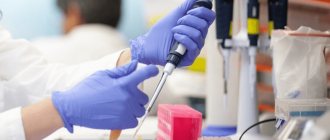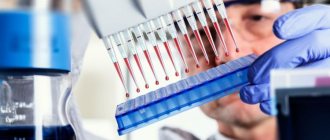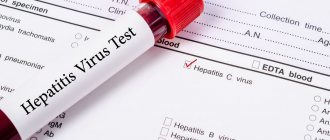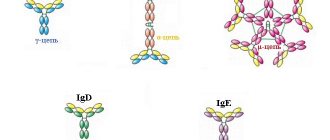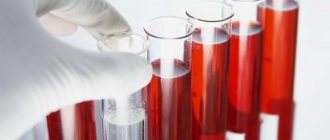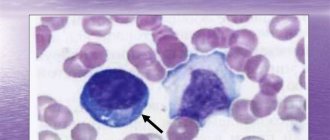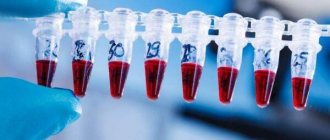In this article we will talk about the nature of the Epstein-Barr virus and numerous tests for this virus, their varieties and decoding. The Epstein-Barr virus or, as they say more often, Epstein-Barr, is sometimes replaced by the abbreviation EBV. From this article you will learn:
- Why, despite all the advantages, the modern real-time PCR reaction is not informative enough;
- What is immunoblotting and what are its advantages in detecting the Epstein-Barr virus in a blood test? When should it be used;
- How much do these tests cost in large laboratories at the beginning of 2020 in Russia.
But we will begin, as usual, with a description of the culprit of today’s article, and we will give an idea of what EBV is and what its place is in living nature.
What are antibodies to Epstein-Barr virus (EBV)?
The causative agent belongs to the group of herpes viruses
Epstein-Barr virus belongs to the group of herpes viruses. It affects the lymphatic system, mucous membranes, central nervous system and almost all internal organs. There are no symptoms when affected, and the person is unaware of the infection. According to international statistics, every 9 out of 10 people are affected by the virus or have previously had it. If the immune system is in good condition at the time of infection, then EBV is completely destroyed and lifelong immunity to the infection is formed.
Antibodies against the virus are produced by the human immune system. They are immunoglobulin (a special type of protein) that is produced by lymphocyte cells. Their purpose is to bind virus antigens. For each antigen, the body produces its own antibodies, which is why, when analyzed by the presence of certain proteins, it is possible to establish infection with various infections.
Interpretation of the analysis
The normal level of indicators in the blood of the patient may vary depending on the specific laboratory. Different reagents are used for blood tests, so it is better to focus on the norm indicated in the corresponding column of the result.
But there are also general, average results:
- Negative result – less than 5 U/ml.
- Doubtful result – 5-20 U/ml.
- Positive result – more than 20 U/ml.
If the result is questionable, you need to be tested for the Epstein-Barr virus again after 2-3 weeks.
To decipher the analysis yourself, you can use the cheat sheet:
- IgG to EBNA (–) (negative), IgG to VCA (–), IgM to VCA (+) (positive) – primary infection, infection occurred recently, specific immunity has not yet been developed.
- IgG to EBNA (–), IgG to VCA (+), IgM to VCA (+) – the infection is primary and occurs in an acute form.
- IgG to EBNA (+), IgG to VCA (+), IgM to VCA (+) – an actively ongoing infectious process, possibly a relapse.
- IgG to EBNA (–), IgG to VCA (–), IgM to VCA (–) – no traces of the virus were detected, immunity was not formed.
- IgG to EBNA (+), IgG to VCA (+), IgM to VCA (–) – the patient is a carrier of the virus, but there are no symptoms of pathology.
- IgG to EBNA (+), IgG to VCA (–), IgM to VCA (–) – a latent form of the disease, infection occurred a very long time ago.
If any indicator is elevated, the risk of a false result is minimal, since serological tests are quite sensitive, they can detect the presence of antibodies in the blood even in patients with immunosuppression.
But there is a risk of false negative results when testing for EBV. There are atypical forms of the disease in which not a single immunoglobulin is elevated. If there is reason to suspect the Epstein-Barr virus, it is necessary to undergo other tests, for example, using the PCR (polymerase chain reaction) method to detect the virus
Important! The likelihood of a false test result increases if a person’s blood contains herpes virus type 6 or cytomegalovirus. But repeated examination eliminates the risk of error. If different results were obtained both times, you need to resort to other tests.
Why is EBV infection dangerous?
Infection may be a trigger for multiple sclerosis
The danger of the virus is that it leads to a decrease in immunity and may be the main reason for the onset of the development of autoimmune pathologies and diabetes. The infection can cause congenital deformities in the child. Also, according to doctors, EBV infection may be the reason why the following dangerous pathologies develop:
- multiple sclerosis,
- oncological lesions,
- severe acute allergies.
In addition, due to its effect on the immune system, the virus causes a weakening of the body’s natural defenses. This leads to a significant complication of any disease and increases the risk of complications of most pathologies and even minor injuries.
Pathogenesis
The entry gate for the EB virus is the epithelium of the mucous membrane of the upper respiratory tract. Penetrating through the intact layers of the mucosa, the virus is adsorbed on the epithelial cells of the nasopharyngeal mucosa, thymus, epithelium of the salivary gland tubules and infects B- and T-lymphocytes , neutrophils , natural macrophages , endothelial cells . The number of affected cells after infection begins to increase through uncontrolled virus-dependent cell proliferation and the virus spreads throughout the body through lymphoid tissues and peripheral blood.
In cells infected with a virus, two types of its reproduction can occur: lytic - productive (leading to lysis of the host cell, i.e., death) and latent, when the cell is not destroyed, and EBV persists in the epithelial cells of the salivary glands, the mucous membrane of the nasopharyngeal region and transformed B lymphocytes leads to permanent carriage of the virus. In the active form (acute infection), predominantly lytic replication of the virus is observed, which is accompanied by the production of viral glycoproteins and manifests itself in manifest forms of the disease.
EBV infection leads to a weakening of the activity of innate resistance factors (inhibition of the T-cell link) and contributes to the formation of a mechanism of an incomplete immune response, mainly of the cellular type (disorder of the mechanism of regulation of the immune response by T-helper types 1 and 2). In conditions of insufficiency/absence of a specific immune response - against the background of suppression of the production of interferon and the production of immunoglobulins, the process of EBV replication is not completely suppressed in the body, and under the influence of immunosuppressive factors (the addition of a mixed infection), the pathogen is reactivated.
It is the disorders of the immune status that are the main pathogenetic background that contributes to the long-term persistence of EBV in tissue cells. EBV, in the process of chronic persistence in the cells of the immune system and epithelium, independently implements complex mechanisms of immunosuppression, which does not allow the body’s immune system to control the infectious process.
Indications for the study
Frequent ARI - indication for analysis
A blood test is performed for the presence of antibodies to EBV only when indicated. The main ones are:
- the presence of symptoms that allow one to suspect mononucleosis of an infectious nature, which always accompanies EBV damage;
- frequent viral infections such as influenza and acute respiratory infections;
- a sore throat that develops 3 times a year or more often;
- a cold, in which there is always a noticeable increase in the size of the lymph nodes and an increase in temperature to high values;
- one-time enlargement of lymph nodes, tonsils and adenoids;
- period of pregnancy planning;
- presence of cancer;
- detection of HIV infection.
Also, in some cases, a blood test for antibodies to the virus is prescribed in the presence of chronic fatigue syndrome.
Prevention
There are no specific measures or means to reduce the likelihood of infection with the EB virus. As a preventative measure, we can recommend measures aimed at breaking the transmission mechanism of the pathogen and increasing immunity :
- Avoid contact with sick people (coughing, sneezing, complaining of a sore throat).
- Do not have unprotected sex.
- Do not allow your child to put their hands/toys in their mouth.
- Increase your immunity (healthy, nutritious diet, hardening, practice periodic maintenance vitamin therapy, avoid stress).
How to prepare for research
On the eve of the test, you should minimize physical activity
To obtain maximum data accuracy during analysis, preparation for the study is required, which consists of the following:
- refusal of any medications the day before donating blood;
- giving up alcohol and tobacco products the day before the test;
- minimizing physical and emotional stress 12 hours before handing over the material;
- refusal to eat 12 hours before the test.
If specific preparation is necessary for individual indications, recommendations are given by the doctor who prescribes a blood test for antibodies.
Preparing for the test
When taking an Epstein-Barr virus test, it is necessary to exclude all factors that could distort the PCR result:
- Biological material must be taken in the morning on an empty stomach.
- On the eve of the PCR test, it is recommended to avoid a heavy dinner. It is better to have a small snack 9 hours before the time of taking the biomaterial.
- Three days before the test, avoid alcohol, energy drinks, fatty, sweet or starchy foods.
- The day before the test, exclude tea and coffee, carbonated drinks.
Before the test, young children are given boiled water (up to 200 ml over half an hour). It is not recommended to take medications starting 10-14 days before PCR, but if they are necessary for health reasons, then their names must be provided to the doctor who will interpret the analysis.
Methods for detecting antibodies to EBV
Antibodies can be detected using several techniques.
Various methods can be used to detect antibodies to the virus.
Heterophilic antibodies
With this method, specific heterophilic antibodies to EBV are determined by agglutination with red blood cells from the blood of a sheep, bull or horse that have undergone special treatment. Detection of this type of antibody is possible within six months from the moment a person is infected. The study is carried out in adults and gives results accuracy of up to 99%. For children, the accuracy of such a study is only 30%.
Serological studies
Serological test is informative after 14 days
With this method, specialized antibodies against the virus are isolated from blood serum. After infection with mononucleosis, the presence of antibodies against EBV is detected 2 weeks after infection. During the study, an enzyme-linked immunosorbent assay is carried out, and anti-complement fluorescence and indirect fluorescence methods are also used.
Antibodies to early antigen
The early antigen and antibodies to it appear first after the moment of infection. Antigens are found only in B lymphocytes and are located in their cytoplasm. Detection of such proteins is possible even during the incubation period. Detection of these antibodies is possible within 6 months from the moment of infection.
Antibodies to capsid antigen
Antibodies to capsid antigen persist for life
Detection of antibodies to a given antigen is a valuable diagnostic result. They are present throughout life, which makes it possible to identify those who have recovered from the virus even after a long period of time from the moment of infection. After infection, antibodies are detected only from 2 months. The presence of these antibodies indicates the body's resistance to EBV.
Antibodies to nuclear antigen
It is possible to detect antibodies to this antigen only at a later stage. They indicate that the process of active recovery has begun, but the virus is still present in the body. After an illness, the test result for antibodies to nuclear antigen may remain positive for a long time.
How can you get infected?
There are four variants of infection with the Epstein-Barr virus:
- By airborne droplets. Herpes type 4 is transmitted by airborne droplets only when the source of infection is an acute form of Epstein-Barr virus infection. In this case, when sneezing, Epstein virus particles can easily become airborne and enter a new body.
- Household contacts. In this case, we are primarily talking about all everyday contacts with an infected person, including shaking hands. And at the same time, it is not necessary that the carrier has an acute form of the disease, since another year and a half after the acute Epstein-Barr viral infection, the carrier can easily infect others through contact.
- Sexual intercourse and kissing. Herpes type 4 is easily transmitted through all types of sexual interaction, as well as through kissing. It is believed that in a third of all infected people, Epstein-Barr can live in the saliva for the rest of their lives, so it is very easy to become infected with it.
- From pregnant woman to child. If a pregnant woman has Epstein-Barr in her blood, then it can easily be transmitted from her to the fetus through the placenta, and in the future to the child.
Of course, understanding how easily it is possible to become infected with the Epstein-Barr virus, the question arises, what about blood transfusions or organ transplants. Naturally, it is also easy to get Epstein-Barr during transfusions and organ transplants, but the above transmission routes are the most common.
Decoding the results
The test results are interpreted by the doctor
The data obtained as a result of the analysis is deciphered by the attending physician. Laboratory workers do not have the right to advise a person regarding the results, and everything they say can only be regarded as a statement of indicators, but not a medical opinion.

